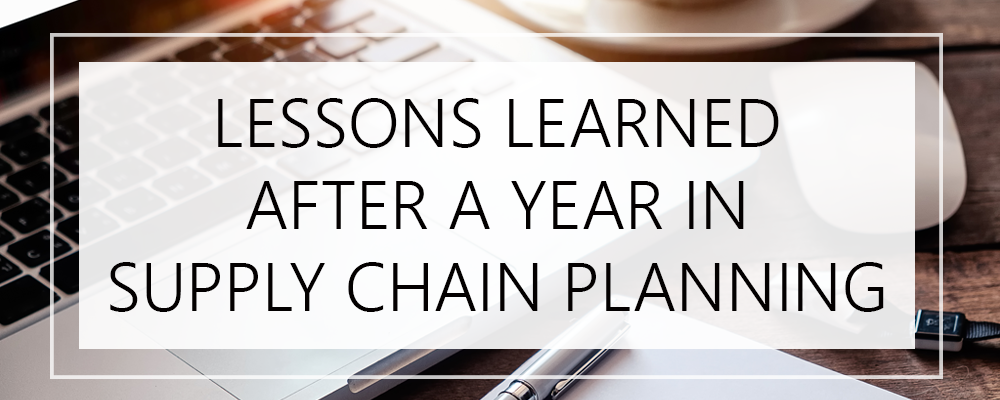A little over a year ago, I ventured into the unchartered territory of supply chain planning. It was an exciting challenge. I had experience as a marketer in the Business Intelligence (BI) and Enterprise Resource Planning (ERP) space. And because ERP solutions often have some supply chain planning functionalities, I thought I could easily apply my knowledge from the ERP space to supply chain planning.
Within a week of getting my feet wet by learning more about the Supply Chain Planning Solutions at Arkieva and in the industry at large, it was clear that the ERP solutions that I was familiar with barely scratched the surface of supply chain planning. While some of those ERP solutions could handle some of the planning functionality for small-sized manufacturers, for larger manufacturers with complex supply chains it left much to be desired.
This realization was a bit of a drag! I had to learn everything from scratch and go back to the drawing board.
Taking a step back, early on in my marketing career, I made the determination that I wanted to have a marketing philosophy that I would guide my strategies. After days of writing and rewriting, I finally came up with my marketing philosophy which reads:
Every day is an opportunity to make a change in the lives of people through our services and products. That change, however, is only possible if we connect deeper beyond the— “buy this! It’s awesome.”
I often think of this philosophy as a mantra of some sort. It serves as a reminder that for each marketing strategy to be successful, it’s essential to understand the target audience. With this in mind, I set off to learn more about the supply chain planning industry, the main players involved in the day-to-day S&OP process, and the challenges that these players face on a daily basis.
Fortunately, Arkieva CEO – Harpal Singh has a published book on Sales and Operations Planning Improvement that’s available to all Arkieva employees. Reading this book gave me the foundational information and practical tips on how businesses can improve their S&OP process. Although the book was practical in nature, it was easy to read and understand.
I was still missing something.
I now understood how businesses could improve their S&OP processes with the right technology solutions and strategies. It was also evident that the improvement in S&OP processes is possible only if businesses change their mindset and commit to improving underlying processes continuously. Since I’m not a supply chain planning professional, I couldn’t fully grasp why it mattered.
Once again, I tapped into the resources available at Arkieva. I had conversations with supply chain consultants and practice directors both informally and formally to find out some of the core problems that our customers face, how we help, and most importantly, why we help. I also took the opportunity each time I interacted with a customer to learn more about their business and their challenges. Through my interactions and self-research over a one-year period, here’s what I’ve learned:
Lessons Learned After a Year in Supply Chain Planning
- Forecast Accuracy vs. Inventory Optimization
There are two schools of thoughts; the first one is that businesses should focus on forecast accuracy and inventory reduction will occur as a byproduct. On the other hand, others believe that businesses should focus on inventory optimization, ensuring that they can reduce inventory levels by figuring out the right levels of safety stocks to keep at different locations. The reason for this disparity sometimes stems from the different objectives that people within an organization might have. While marketing and sales might be interested in improved service levels, which could mean higher safety stocks, the finance team might be interested in reducing the soaring inventory costs. The demand planner might also be interested in improved forecast accuracy as that is an indication of a job well done. Often, looking at the current business situation holistically can help businesses come to a better place with a plan of action.
[ Related: Reporting Forecast Accuracy At Sales and Operations Planning Meetings ]
- Supply Chain Knowledge Expertise is Just as Important as the Technology
For businesses looking for a supply chain technology solution, the importance of provider’s domain expertise is just as important as the technology. The reason is that every technology implementation is only as good as the way that it’s used. Meaning, you can have the most sophisticated technology solution but if it’s not implemented with a careful understanding and translation of your current business processes, the solution may not serve its full purpose. Hence, in selecting a technology solution, it’s essential for businesses to find long-term strategic partners. These types of partners will get to know your business and raise objections when the technology implementation ideas do not align with best practices. For most of the customers at Arkieva, the supply chain expertise available at Arkieva while difficult to quantify has been an invaluable part of the partnership.
[ Read More: Supply Chain Talk: What Makes a Supply Chain Technology Partnership Work? ]
- Supply Chain Visibility Has Varying Meanings
At every supply chain conference that I attend, for every ten people that I have a conversation with, about 8 out of the 10, mention supply chain visibility as a top concern. What I found interesting is that supply chain visibility means different things to different people. The type of visibility needed often stems from the individual’s role within the organization. A VP of Supply Chain may be looking for a ‘360-degree’ view into all operational activities, whereas a demand planner might be interested in managing forecasting metrics and connecting with other areas of production. Supply chain visibility is also sometimes viewed as a ‘buzz’ term. If you are looking for supply chain visibility, it might be critical to spend some time to define what that means to you and why it even matters.
[You May Also Like: Forget the Supply Chain of 2020. Here are 3 Things That Supply Chains Need Today. ]
- Supply Chain Standardization is Mostly a Wish List Item
In most organizations, the different departments operate in silos, and often there aren’t any collaboration between the different departments. This kind of siloed approach to business management is even more elevated when dealing with business units operating as subsidiaries. The goal is with standardization often stems from the simple concept of not reinventing the wheel by sharing knowledge, reducing costs, and improving efficiency. To implement standard business practices, there is the need to identify business goals and evaluate those goals to determine if it’s worth the trouble. Then finally, implement those standard processes by creating policies and procedures around the processes. While most businesses would agree that having standardized processes across the supply chain is an efficient practice, a lot of businesses today do not have standard supply chain strategies in place.
[Read Also: Supply Chain Talk: The Secret to Standardization – Imagine Wearing a Standard Shoe Design on Both Feet ]
- Most Businesses Don’t Fix Something Unless It Hurts
Now and then, we find businesses that realize that they are headed down the wrong path and try to fix issues proactively. In these cases, the businesses sometimes identify that their Excel spreadsheets are becoming increasingly complex or that their business is experiencing exponential growth and can foresee possible downfalls. Unfortunately, these cases are the exception. Most businesses tend to solve supply chain planning problems after struggling with the issue often for an exponentially painful amount of time. In some cases, it even takes a unique turn of events, like a change in management, etc., for the business to act. The bottom line is that people don’t like change even when it’s painfully obvious that it’s a necessary evil.
[ Related: What’s the cost of doing nothing? Easy tips for uncovering problems before they turn into disasters ]
In the end, while learning about the players of the supply chain industry was a new experience, the supply chain world is something that affects every one of us. I’m mesmerized by the delicately orchestrated process that goes into not just planning what to produce and when to produce, but how I the end customer, easily has access to products that I want when I want them.
It’s fascinating.
When shopping at my local grocery store, I sometimes feel like I’m no longer just buying a bag of my favorite Sunsweet dried mango slices, I’m also affecting the next manufacturing plan. I think it’s amazing!
What will I discover in year two of my journey? Let’s wait and see.
Enjoyed this post? Subscribe or follow Arkieva on Linkedin, Twitter, and Facebook for blog updates.






